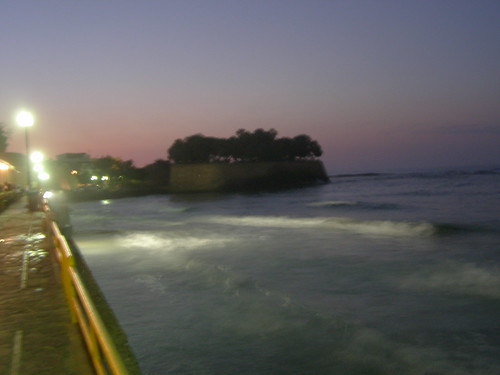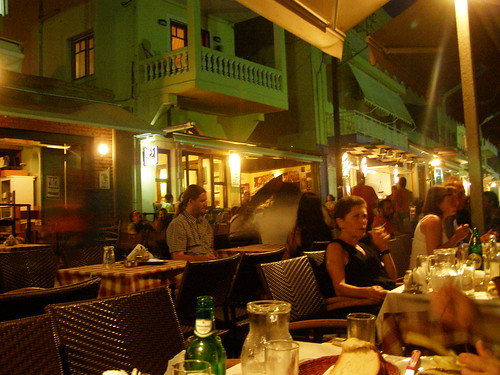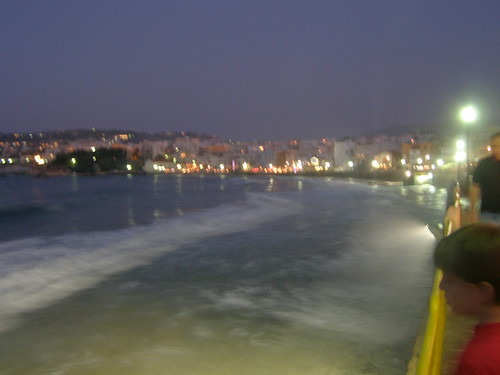Koum Kapi, a coastal area located eastwards of the main town of Hania, takes its name from the Turkish language, meaning 'gate of sand', which refers to the eastern gate (still standing) built into the wall that surrounded the town to guard it and its citizens in older times. Before Ottoman rule, the Venetians had already named it Sabbionara, again meaning 'sand gate'. The bulwark is now covered with trees, and there used to be a cafe operating under their shade. I was lucky enough to enjoy the view from this spot; it has closed down now.
One hundred years ago, Koum Kapi's sandy shores were once covered in straw huts, homes to the 'χαλικούτιδες' (halikoutides), the moslem servant tinkerers of Arab-African descent, who left the town during the last major population exchange in 1922 after the burning of Smyrna. The photo shows their dwellings: a rather unusual structure inhabited by unusual people. This photo has been taken from the book Chania outside the Wall, by Aimilia Kladou-Bletsa.
Koum Kapi gradually turned into another quick-build shoddy-construction ghetto: rows of workers' houses, crammed beside each other like sardines in a can, one room tacked onto the other with no town planning taken into consideration. The area resembled a slum and was considered a 'bad' neighbourhood, the kind where illicit activities take place. The area underwent major re-imaging in the mid-90s; as soon as the slum housing disappeared and the coastal road was turned into a promenade suitable for the evening volta (stroll), along came the developers, turning it into a glitzy cafe-bar neighbourhood. Before this happened, this is what it looked like (again taken from Aimilia Kladou-Bletsa's fascinating book), a little as I remember it when I first came to Greece:
It is now the most vibrant part of town, and there is never an empty seat at the eateries in good weather. It stretches along the coast starting at the right of the touristy old port, the eastern side of the Venetian city wall which is still standing; an open-air theatre operates below it, in the area of a former moat, throughout the summer. Passing St Lucia's gate, Koum Kapi ends just behind the stately Villa Koundourou, a 100-year old country house bequeathed to the state by the owner, now turned into an arts centre.
It seems that Koum Kapi is a well kept secret among the locals, as few foreign tourists are seen strolling along the promenade; while the locals walk slowly along the road enjoying the view and the misty breeze, the Northern European tourists jostle against each other for walking space at the old port in the high summer season.
It was a hot night, the theater in the moat was staging a children's play, the car park next to the theater - again housed in the moat - was choked with cars to full capacity. We were lucky to find a space near the entrance just as we were getting ready to leave it after driving right through it! This was the scariest part of the evening: getting through choking traffic with two youngsters in tow. But they weren't the only children being dragged to their parents' favorite hangout: my children met up with some of their friends from the day camp they have been attending. But the strollers were primarily young Greeks: smiling faces with bursts of laughter, all dressed in the latest fashion.
We took a walk along the promenade. The music coming from the bars, coupled with the style of the older houses, most of which have been renovated, will make you think you are on a backstreet in Havana. The food places were located closer to St Lucia's gate, while the open-air bars and cafes were found by Villa Koundourou. We walked back to find a seat in one of the little bistro-style tavernas, settling on the first place we found with empty seats. The sign above the indoor area gave its name as Kazimi. The seats were positioned next to the promenade, so that we had a direct view of the ocean, with the occassional spray of sea as the waves hit the breakwater. It felt fabulous to sit so close to the sea, but spare a thought for the locals: the music got louder and louder as the night wore on, and apparently no one goes home until well into the early hours of the morning...
We decided to order something simple: a mixed grill, more popularly known in Greek as a 'poikilia' (variety). There was a choice of small, medium and large: we chose medium for our family of two adults and two children.
'Anything to drink?' asked the not-very-talkative owner-waiter-cook.
'Two 'gazozes' for the children (locally produced cream soda), and a couple of ice-cold beers from the tap for us,' my husband replied.
'Sorry, I haven't yet bought the equipment for beer off the tap. We're new in the business, you see.' My husband was most disappointed. I wasn't too fussed; even if the food didn't come up to our expectations from this newly-opened eatery and its inexperienced owner, you have to see Koum Kapi for what it is: a good place to chill out. I wouldn't go to Koum Kapi otherwise. If all I wanted was good food, I'd stay at home. In any case, what we got for 31 euro, drinks included, was not just the food. There was also the intoxicating view and the lively atmosphere.
Admittedly, the food wasn't all home-made, judging by the chicken nuggets and uniform-sized schnitzel, but the meatballs were delicious, and the chicken souvlaki was the most succulent I had had in ages. The potato chips were crisp, but the sausages were the cheerio type, which would have gone down well at a children's party. As an added bonus, there was plenty to take home with us for the next day's lunch (2 kids count for 1 adult). It went well with the leftover boureki.

Funnily enough, I found myself at the same spot the next night with a friend. The bistro didn't fill up, while all the others around it were packed. Is this the effect I have on places?!
©All Rights Reserved/Organically cooked. No part of this blog may be reproduced and/or copied by any means without prior consent from Maria Verivaki.







a lovely place to visit. i wanna go there and explore the place sometime MK.
ReplyDeletesorry for not visiting these past few days because i used the 3-day weekend we had in our country to wander around my neigbouring towns and city.
have a great day ahead.
great way to chill!
ReplyDeleteFun post. I love the sea pictures and wistfully imagine sitting there as the salt spray comes up.
ReplyDeleteI would love to have the effect on places that it is less crowded!
Love your evening pics and thoroughly enjoyed all the historical background of this place!
ReplyDeleteMaria, this is a great post for "taxidiaris"!
ReplyDeleteThat was fun; thanks for taking us along! Cream soda? I haven't been able to find that for decades. Gazoz? Israelis used to use the word for soda water or maybe any carbonated (i.e. with "gaz") beverage.
ReplyDelete